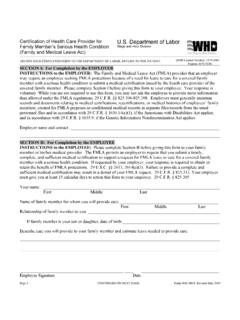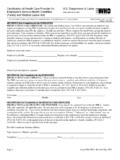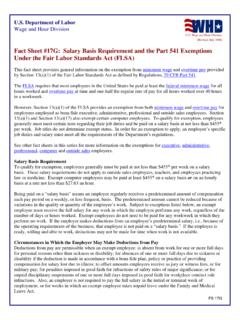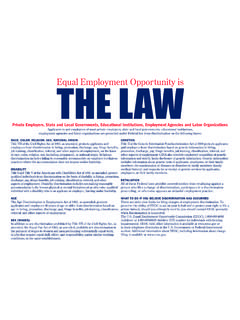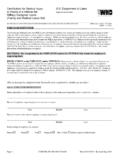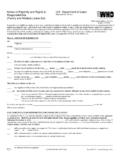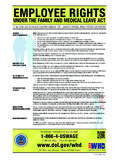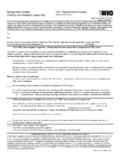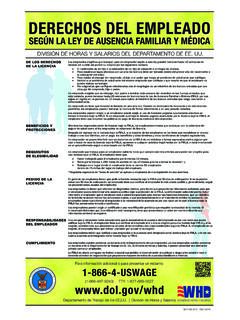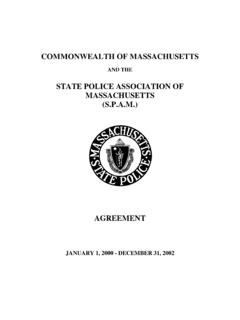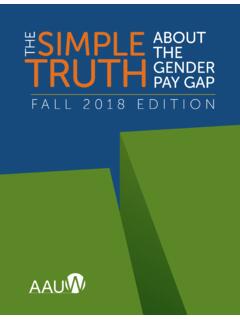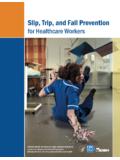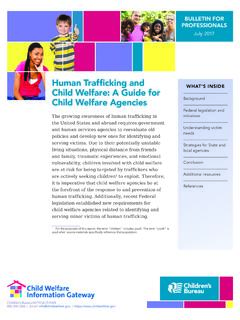Transcription of Employment Fundamentals of Career Transition …
1 Department of labor Employment Fundamentals of Career Transition Participant guide Revision Date: 11 2019 Employment Fundamentals of Career Transition Participant guide 2 Table of Content Section 1 Getting Started .. 5 Objectives .. 5 Course Overview .. 6 Prerequisites .. 7 Career Transition Journey Map .. 8 Activity: Where Are You Now? .. 9 Section 2 Planning Your Next Steps .. 11 Factors to Consider When Selecting a Career .. 11 labor Market Research .. 13 Activity: Use labor Market Research to Research Occupations & Identify Requirements .. 15 Activity: Identify the Occupation Outlook & Salary Range .. 17 Activity: Final Analysis .. 19 Additional Transition Tracks .. 20 Getting Help at the American Job Center (AJC) .. 21 Activity: Access the AJC Online .. 21 Section 3 Preparing for Success .. 24 Think Like an Employer.
2 26 Adjustment to the Civilian Workplace .. 26 Translating Military Terminology into Civilian Terms .. 29 Employment History Outline .. 31 Activity: Create Your Employment History Outline .. 31 Resumes .. 32 Create a Resume that Stands Out with the STAR Method .. 35 What is the STAR Method? .. 35 Putting STAR into Practice .. 36 Activity: Creating an Achievement Statement with STAR .. 37 Professional Introduction .. 38 Activity: Draft Your Professional Introduction Statement .. 39 Networking .. 42 Activity: Identify Your Network Contacts .. 42 Expanding Your Network to Online Networking .. 44 Using LinkedIn .. 45 Employment Fundamentals of Career Transition Participant guide 3 Effective LinkedIn Profiles .. 45 Getting Started and Profile Photo .. 45 Activity: Create Your Headline .. 46 Activity: Draft Your Summary Statement .. 46 Section 4 Applying for a Job.
3 52 How Hiring Occurs .. 52 Selecting an Application Method .. 53 Seeking Out Veteran Ready Employers .. 54 Activity: Job Search .. 54 Analyze a Job Posting .. 56 Activity: Analyze a Job Posting for Keywords & information .. 57 Completing a Job Application .. 59 After the Application Process .. 60 Section 5 Interviewing for a Job .. 62 Types of Interviews .. 62 Types of Interview Questions .. 64 STAR Method for Interview Questions .. 66 Section 6 Receiving a Job Offer .. 69 Evaluating a Job Offer .. 69 Section 7 Communicating Your Decision .. 71 Negotiating Job Offers .. 72 How to Negotiate .. 73 Negotiation Outcome .. 74 Section 8 Summing It Up .. 76 Section 9 Appendix .. 78 Answering Interview Questions Practice .. 78 Index of Online Resources .. 80 Employment Fundamentals of Career Transition Participant guide 4 Getting Started 1 Employment Fundamentals of Career Transition Participant guide 5 Section 1 Getting Started Thank you for your service, and congratulations on embarking on the next phase of your Career !
4 The purpose of this course is to provide you with the essential tools and resources you need to evaluate Career options, gain information for Employment , and understand the Fundamentals of the Employment process. Objectives Upon completion of this training, you will have learned how to: Conduct occupational research and job search for selected careers. Complete the Gap Analysis. Understand the civilian work environment. Use the STAR method to write achievement statements. Recognize the basic sections of a resume. Draft an Employment history outline. Draft a professional introduction to use for networking. Identify your network contacts. Draft a headline and summary for your LinkedIn profile. Analyze a job vacancy posting. Connect your skills and abilities with the needs of an employer. Identify the relevant factors in evaluating a job offer. Employment Fundamentals of Career Transition Participant guide 6 Course Overview In this training, we will discuss the Fundamentals of the Employment process, which is explained in the six stages below.
5 The table below shows a breakdown of each stage, including the focus, topics, and activities that we will cover in each lesson. Employment Process Stage Stage Focus Topics & Activities 1. Plan your next steps. What do you want to do next? Factors to consider when selecting a Career labor market research Activity: Career research Additional tracks Activity: Getting help at your American Job Center 2. Prepare for success. What documents and items do you need to prepare for the Employment process? Adjusting to the civilian workplace Translating military terminology into civilian terms Employment history outline Activity: Start your Employment history outline Basics of resume Activity: Write a STAR achievement statement Professional introduction Activity: Draft your professional introduction Networking Activity: Identify your network contacts Online networking Activity: Create a LinkedIn profile and draft your headline and summary statement Employment Fundamentals of Career Transition Participant guide 7 Employment Process Stage Stage Focus Topics & Activities 3.
6 Apply for a job. How do you make your application stand out from the crowd? How hiring occurs Selecting an application method Seeking out veteran friendly employers Activity: Search for a job Analyzing a job posting Activity: Analyze job posting for keywords and information Tips for completing an Employment application Follow up on job application 4. Interview for a job. How will you demonstrate your value to an employer? Types of interviews Types of questions Activity: Mock interview 5. Receive a job offer. What do you need to do after you get the job offer? Know the terms of offer Activity: Evaluate the job offer 6. Communicate your decision. How do you inform the employer of your decision? Informing employer of your decision Negotiating job offers Prerequisites The Transition Assistance Program (TAP) curriculum is an outcome based, modular curriculum with standardized learning objectives.
7 The modules you have completed during the DoD Transition Day (Managing Your Transition , Military Occupational Code [MOC] Crosswalk, and Financial Planning for Transition ) will assist you during the DOLEW. Bring the following items to class each day: VMET Performance evaluations (to help you develop STAR statements) Military and college transcripts MOC Crosswalk Gap Analysis Laptop or notebook (if allowed) Employment Fundamentals of Career Transition Participant guide 8 Career Transition Journey Map This manual complements the Transition Assistance Program (TAP) curriculum by providing you with access to tools and best practice that will help you to Transition from military service to a civilian Career . The curriculum s Career Transition Journey Map is below. This map provides specific guidelines and timeframes to manage and navigate your journey toward a new Career path. Career Transition Journey Map Timetable 18 to 24 Months Before Transition 12 to 18 Months Before Transition 6 to 12 Months Before Transition 0 to 6 Months Before Transition Primary Activities Assessment and Career Exploration Preparation Activities Engagement Activities Transition Description Meet with local TAP Counselor.
8 Complete self assessment. Create a LinkedIn account. Identify a mentor. Begin exploring Career options. Develop an Individual Transition Plan (ITP). Register for and attend TAP workshops and additional tracks (RETIRING). Attend any remaining TAP workshops and tracks. Explore SkillBridge or Career Skills opportunities. Explore other training opportunities. Create a master resume. Register for and attend TAP workshops and additional tracks (SEPARATING). Begin & refine job search. Complete targeted resume. Sign up for a free year of LinkedIn Premium Subscription. Targeted networking. Practice interviewing. Attend Career fairs. Connect with an American Job Center (AJC) locally or at post separation location. Apply and interview for positions. Continue to network and stay involved on LinkedIn and other social media sites. Outcome High Quality Civilian Career Employment Fundamentals of Career Transition Participant guide 9 Activity: Where Are You Now?
9 Take a few minutes to complete the following sentences. Be prepared to share your answers with the group. 1. My current job in the military 2. What I find most rewarding about my job 3. Some of the strengths I ve developed 4. After the military, I want 5. What I hope to gain from this course Employment Fundamentals of Career Transition Participant guide 10 Planning Your Next Steps2 Employment Fundamentals of Career Transition Participant guide 11 Section 2 Planning Your Next Steps "What do you want to do next? is an important question that you need to be able to answer before you can prepare for the Employment process. In this section, you will: Evaluate your Career options using important Career factors and information from the labor market. Use this information along with your insights from the MOC Crosswalk and Financial Planning for Transition workshop to complete your Gap Analysis.
10 Factors to Consider When Selecting a Career When selecting a Career , think about the following factors: Interests Pursue something you re truly interested in. If you don t like working with sick people, don t be pressured into becoming a nurse just because there is a high demand for nurses. Values As you plan for your future Career , make a list of your top priorities to ensure this Career matches up. How will you achieve a work life balance? Is having weekends off important? Work Style Everyone has their own unique work style. Some enjoy deadlines and structure while others thrive with little guidance or management. Make sure the Career path you choose provides you with an environment you can thrive in. Location Is the job in demand where you are going to live, or do you need to relocate? When contemplating relocation, strongly consider housing availability, associated moving costs, cost of living, and family adjustment.
